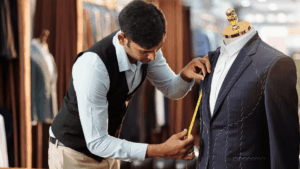For years, high fashion felt like a secret club. The keys were held by a few magazine editors, rich buyers, and famous movie stars. It was a world of exclusivity and mystery where trends were decided in Parisian ateliers and handed down to the masses. But then, the Internet happened. And with it came a new kind of celebrity, the influencer millionaire, who didn’t just knock on the door of high fashion, they kicked it wide open.
There’s no doubt the rise of social media has changed almost every industry, but its impact on luxury fashion has been nothing short of a revolution. These digital-first entrepreneurs went from taking pictures in their bedrooms to sitting front row at Fashion Week, and now they’re the ones setting the trends. In this article, we will look at how this new breed of fashion leaders changed how luxury brands operate, market their clothes, and even define what high-end means in the modern world.
The Old Guard vs. the New Wave
If you look back 15 or 20 years ago in the fashion world, it was a very top-down system. The Old Guard was made up of legacy fashion mags like Vogue and Harper’s Bazaar. Their editors were the ultimate authorities on taste. They decided which designers were important, which collections mattered, and which movie stars would be on the cover.
The whole industry revolved around them. Runway shows and fashion trends were for those editors and a select group of department store buyers. It was their job to translate the very conceptual, often unwearable, runway looks for the average consumer.
Then came the new wave, powered by the Internet. It started with fashion bloggers in the late 2000s. These were just regular people with a passion for clothes, a camera, and a point of view. They started sharing their personal style and thoughts on fashion, and to the surprise of the establishment, people listened. When Instagram launched, this trend went into overdrive. Suddenly, anyone could be a publisher. It’s a fact that this accessibility was the first major crack in the ivory tower of high fashion. The power was shifting from a few institutions to millions of individuals.

How Influencer Millionaires Changed High-end Fashion
Why Use Influencer Marketing?
Influencer-led marketing has become a key strategy for tech and gaming brands to launch new products. Influencers attract audiences deeply interested in a specific niche, making them a valuable channel for targeted campaigns. Traditional online marketing often relies on a broad “shotgun” approach, reaching many people with little interest in the topic. By contrast, influencer marketing focuses on audiences already engaged in the brand’s field, reducing wasted reach and increasing relevance.
In the iGaming industry, this is especially effective. Casino streamers, esports personalities, and betting tipsters often command loyal followings who actively seek content about games, strategies, and promotions. By partnering with these influencers, iGaming brands can connect directly with players already primed for engagement—whether it’s showcasing a new slot release, promoting a tournament, or highlighting exclusive bonuses.
That said, influencer-led campaigns don’t replace the standard onboarding process for brands and players, especially for newer online casinos. Players are still encouraged to visit comparison sites, read reviews, and learn about game selection, bonuses, and licensing. Established platforms like askgamblers.com have built a reputation for providing transparent reviews, player feedback, and dispute resolution, making them a trusted source when researching casinos. Influencer content can spark interest, but authoritative comparison sites remain essential for helping players make confident, informed choices.
Redefining Aspirational
The very definition of what’s “aspirational” in fashion has been turned on its head. For a long time, the ultimate fashion goal was to look like a distant, untouchable celebrity on the red carpet. The look was something to be admired from afar, but not something you could actually achieve in your own life. It was a fantasy.
Influencers changed this by making luxury feel attainable. A big part of their appeal was their “high-low” approach to dressing. They would expertly mix a high-end designer piece, like a Chanel handbag or Gucci belt, with affordable items from Zara or H&M.
This sent a new message: You don’t need a head-to-toe designer look to be stylish. You could buy one luxury piece and mix it into your existing wardrobe. This made high fashion feel less intimidating and more like a fun form of self-expression.
So, this created a new kind of aspirational lifestyle. Followers didn’t just want the influencer’s clothes; they wanted their life. They followed along on their vacations, saw what they ate for breakfast, and felt like they knew them personally. This relatability built a trust that a traditional ad could never replicate. When an influencer recommended a $5,000 handbag, it didn’t feel like a corporate sales pitch. It felt like a style tip from a cool, successful friend.
The Rise of the Influencer-led Brand
As their power grew, many influencer millionaires asked themselves: Why just promote other people’s brands when I can create my own? And so, the influencer-led fashion and beauty lines were born. With a massive built-in audience ready to buy whatever they produced, they had a huge advantage over any new business.
Let’s take Chiara Ferragni’s eponymous brand or Arielle Charnas’s Something Navy. These influencers didn’t have to spend millions on advertising or hope a department store would pick up their line. They had a direct-to-consumer business model from day one. They could announce a product launch on their Instagram, and their followers would flock to their website. It’s a fact that they completely bypassed the industry’s traditional gatekeepers.
Plus, they had years of market research at their fingertips. By interacting with their followers every day, they knew exactly what their audience wanted, what styles they liked, what price they were willing to pay, and what sizes they needed. They could create products with the confidence that there was already a market for them. This inside knowledge is something traditional brands spend millions trying to get, but for influencers, it was just part of their daily routine.
Changing the Face of Luxury
The influence of these digital stars has gone beyond marketing and is now changing the actual clothes that high-end brands design. One of the biggest shifts has been the rise of “street style.” Fashion Week used to be all about the runway shows. Now, the pictures of what influencers, editors, and models are wearing on the street outside the shows are often more important and more impactful.
This has led to the “Instagrammable” effect. Designers are now designing with social media in mind. This means bold logos that are easily recognizable in a photo, unique silhouettes that stand out in a crowded feed, and bright, eye-catching colors. The revival of logo-heavy prints, like the Fendi Zucca or the Dior Oblique, was driven almost entirely by their popularity on Instagram. Brands realized that having their logo all over social media was free advertising.
Another huge shift has been the push for more diversity and inclusivity. For decades, the world of high fashion was very homogeneous. Influencers came from all over the world and represented a wide range of body types, ethnicities, and personal styles. As they gained power, they brought their audiences with them, and those audiences wanted to see themselves represented. And so, luxury brands, which were often very slow to change, finally started using more diverse models and offering more sizes.
Looking Ahead and Problems to Watch
Even with all this change, the influencer world is not without its problems. Firstly, the market is oversaturated—with the barrier to entry so low it feels like everyone is an influencer. This has made it harder for both brands and consumers to know who to trust.
This has led to an authenticity crisis. As the money in influencer marketing has grown, the lines between a real recommendation and a paid ad have become blurred. Followers are becoming more skeptical of sponsored posts, and there’s a growing demand for transparency. On top of that, there are serious questions around sustainability. The influencer model is built on a culture of “hauls” and constant newness, which promotes fast fashion even when dealing with high-end products. It’s a big challenge for an industry trying to become more responsible.

fashionabc is a fashion technology platform, comprising a digital directory and various other digital tools and supply chain solutions for the fashion industry ecosystem, that focus on ethical fashion and sustainability. We are building inclusive digital transformation tools for fashion professionals who are willing to take steps towards a more sustainable ethical fashion industry, by adopting AI and DLT blockchain technology.
* building digital profile and IP solutions for fashion businesses
* tackle issues such as provenance and counterfeit in supply chain
* contribute to the construction of a meritocratic ethical fashion industry which is certified and part of the circular economy











